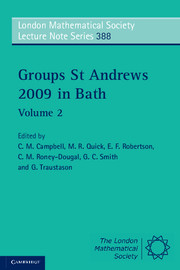Book contents
- Frontmatter
- Contents
- Introduction
- Algorithms for matrix groups
- Residual properties of 1-relator groups
- Words and groups
- The modular isomorphism problem for the groups of order 512
- Recent progress in the symmetric generation of groups
- Discriminating groups: a comprehensive overview
- Extending the Kegel Wielandt theorem through π-decomposable groups
- On the prime graph of a finite group
- Applications of Lie rings with finite cyclic grading
- Pronormal subgroups and transitivity of some subgroup properties
- On Engel and positive laws
- Maximal subgroups of odd index in finite groups with simple classical socle
- Some classic and nearly classic problems on varieties of groups
- Generalizations of the Sylow theorem
- Engel groups
- Lie methods in Engel groups
- On the degree of commutativity of p-groups of maximal class
- Class preserving automorphisms of finite p-groups: a survey
- Symmetric colorings of finite groups
- References
Discriminating groups: a comprehensive overview
Published online by Cambridge University Press: 05 July 2011
- Frontmatter
- Contents
- Introduction
- Algorithms for matrix groups
- Residual properties of 1-relator groups
- Words and groups
- The modular isomorphism problem for the groups of order 512
- Recent progress in the symmetric generation of groups
- Discriminating groups: a comprehensive overview
- Extending the Kegel Wielandt theorem through π-decomposable groups
- On the prime graph of a finite group
- Applications of Lie rings with finite cyclic grading
- Pronormal subgroups and transitivity of some subgroup properties
- On Engel and positive laws
- Maximal subgroups of odd index in finite groups with simple classical socle
- Some classic and nearly classic problems on varieties of groups
- Generalizations of the Sylow theorem
- Engel groups
- Lie methods in Engel groups
- On the degree of commutativity of p-groups of maximal class
- Class preserving automorphisms of finite p-groups: a survey
- Symmetric colorings of finite groups
- References
Summary
Abstract
Discriminating groups were introduced by Baumslag, Myasnikov and Remeslennikov as an outgrowth of their theory of algebraic geometry over groups. Algebraic geometry over groups was the main method of attack used by Kharlampovich and Myasnikov in their solution of the celebrated Tarski conjectures. The class of discriminating groups, however, has taken on a life of its own and has been an object of a considerable amount of study. In this paper we survey the large array of results concerning the class of discriminating groups that have been developed over the past decade.
Introduction
Discriminating groups were introduced by Baumslag, Myasnikov and Remeslennikov as an outgrowth of their theory of algebraic geometry over groups. Algebraic geometry over groups was the main method of attack used by O. Kharlampovich and A. Myasnikov in their solution of the celebrated Tarski conjectures. The class of discriminating groups, however, has taken on a life of its own and has been an object of a considerable amount of study. In this paper we survey the large array of results concerning the class of discriminating groups that have been developed over the past decade.
In Section 1, we define discrimination for groups and describe its ties to other areas. Also the concept of trivially discriminating (TD) groups is introduced, and the concept of squarelike groups is defined. It is also indicated how to define discrimination for arbitrary algebraic systems. It is also shown how to generalize the concept of squarelike to arbitrary algebras.
- Type
- Chapter
- Information
- Groups St Andrews 2009 in Bath , pp. 395 - 414Publisher: Cambridge University PressPrint publication year: 2011



